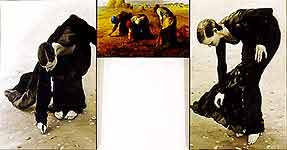| Biography | Review | Artists Represented | Chen Dan Qing

|
| Biography | Review | Artists Represented | Chen Dan Qing |

|
|
Born in China, currently resides in New York City |
|
|
1997 |
Sandra Gering Gallery, New York |
|
1995 |
Solo Exhibition, National Dr. Sun Yat-sen Memorial Hall |
|
1994 |
Solo Exhibition, Art Centre of Design, Pasadena |
|
1992 |
California Institute of Arts, California |
|
1991 |
Baruch College Gallery, New York |
|
1987 |
Santa Ann Modern Art Museum, Santa Ann, California |
|
1986 |
Montgomery Gallery, San Francisco |
|
1984 |
Cork Gallery, Lincoln Centre, New York Solo Exhibition, Adams House, Harvard University |
|
1983 |
Solo Exhibition, Wally Findley Gallery, New York |
|
1982 |
Smith College Museum of Art |
|
1977 |
National Art Exhibition, Beijing |
Looking at To Be Named #1 by Chen Dan Qing, written by Ackar Abbas
The central panel of To Be Named #1 is a copy of Millet's famous painting of 1857 "The Gleaners," which shows three women bending down to pick wheat in a field. In Dan Qing's version, the top part of Millet's work has been cropped, so that much of the sky and the crows have been removed. The result is that greater attention is directed to the human figures than to the milieu. This central panel is flanked and dwarfed by two larger ones, painted after black and white photographs from the fashion magazine Bazaar. They show an elegantly androgynous model in a flowing back dress, bending over to pick seashells on a beach, in a pose remarkably similar to those of Millet's peasant women.
Here there is no attempt to update or to adapt a style. Millet is not drawn into the painter's own figurations. The Millet here has to be carefully preserved. Millet's painting does not signify an image from nature, but is used as an example of second nature. Danqing says, "we never see with our own eyes." Vision is mediated or damaged; and the care expended on preservation is a displaced indication of the extent of the damage. The careful copy we might say is a means of saving appearances; it defines the rules of behavior in second nature, the appropriate form of courtesy. The juxtaposition of Millet and Bazaar may suggest a number of contrasts such as the world of work versus the world of leisure, the different relations between body and clothes, and nature set against the artifice of fashion. What Danqing prefers to say is that the juxtapositions are "not true", they are not even his. They result merely from chance and the workings of memory, from a chance remembering of dispersed bodily experiences where the perception of a similitude merely initiates a flow of memory. "What is true in second nature?" Danqing asks. Ackar Abbas, teaches in the Department of Comparative Literature For further information, please contact: |
|